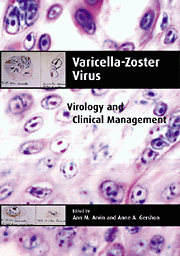Book contents
- Frontmatter
- Contents
- List of contributors
- Preface
- Introduction
- Part I History
- Part II Molecular Biology and Pathogenesis
- 2 Molecular evolution of alphaherpesviruses
- 3 DNA replication
- 4 Viral proteins
- 5 Pathogenesis of primary infection
- 6 Pathogenesis of latency and reactivation
- 7 Host response to primary infection
- 8 Host response during latency and reactivation
- 9 Animal models of infection
- Part III Epidemiology and Clinical Manifestations
- Part IV Laboratory Diagnosis
- Part V Treatment and Prevention
- Index
- Plate section
5 - Pathogenesis of primary infection
from Part II - Molecular Biology and Pathogenesis
Published online by Cambridge University Press: 02 March 2010
- Frontmatter
- Contents
- List of contributors
- Preface
- Introduction
- Part I History
- Part II Molecular Biology and Pathogenesis
- 2 Molecular evolution of alphaherpesviruses
- 3 DNA replication
- 4 Viral proteins
- 5 Pathogenesis of primary infection
- 6 Pathogenesis of latency and reactivation
- 7 Host response to primary infection
- 8 Host response during latency and reactivation
- 9 Animal models of infection
- Part III Epidemiology and Clinical Manifestations
- Part IV Laboratory Diagnosis
- Part V Treatment and Prevention
- Index
- Plate section
Summary
Introduction
The pathogenesis of primary VZV infection can be considered in the broader context of new information about the evolution of the herpesviruses. On a geologic time scale, herpesviruses existed in the Jurassic and Cretaceous period 200 to 70 million years before the present time. Molecular phylogenetic analyses indicate that the origins of the ancestral VZV date from about 60–70 million years ago, during the Paleocene epoch, the era which followed the demise of the large dinosaurs and was associated with the expansion of mammals (McGeoch & Cook, 1994). The herpesviruses must have evolved in ancestral primates that derived from a small mammal between 70 to 50 million years ago. The dwarf lemur of Madagascar is an extant primate which may retain some characteristics of this ancestral Primate order (Martin, 1990) (Figure 5.1). As the primates assumed more simian features from 70 to 25 million years ago, the genus Aegyptopithecus appeared as the ancestral anthropoid and ancestral VZV presumably coevolved through the same genus (Fleagle, 1998; Stewart & Disotell, 1998). During the subsequent major branching of simians and great apes, ancestral VZV cospeciated with the apes and eventually cospeciated with hominoids, as they evolved in Africa over the prior 4 million years. Australopithecus was replaced by Homo erectus less than 2 million years ago. In turn, about 100000 years ago, Homo erectus was succeeded by Homo sapiens. An increase in population of the highly adapted Homo sapiens in Africa is thought to have been followed by migrations, out of Africa, initially to the middle East, India and China, and subsequently to Europe.
- Type
- Chapter
- Information
- Varicella-Zoster VirusVirology and Clinical Management, pp. 105 - 122Publisher: Cambridge University PressPrint publication year: 2000
- 4
- Cited by

